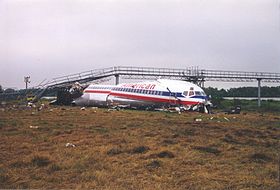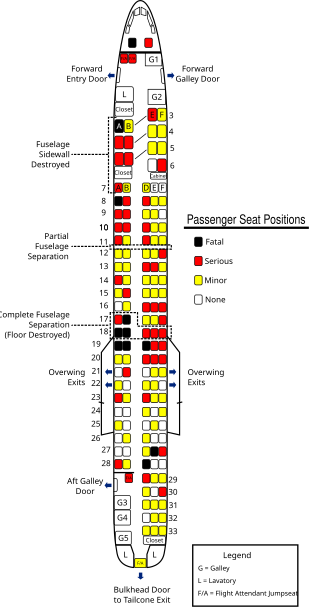American Airlines Flight 1420
| American Airlines Flight 1420 | |
|---|---|
|
The wreckage of N215AA after the accident |
|
| Accident summary | |
| Accident type | Rolling over the runway |
| place |
|
| date | June 1, 1999 |
| Fatalities | 11 |
| Survivors | 134 |
| Injured | 110 |
| Aircraft | |
| Aircraft type | McDonnell Douglas MD-82 |
| operator | American Airlines |
| Mark | N215AA |
| Departure airport |
|
| Destination airport |
|
| Passengers | 139 |
| crew | 6th |
| Lists of aviation accidents | |
American Airlines Flight 1420 was a scheduled flight from Dallas / Fort Worth International Airport to Little Rock National Airport in Arkansas . On June 1, 1999, the shot McDonnell Douglas MD-82 with the air vehicle registration N215AA at which the flight was carried out on landing in Little Rock on the runway beyond. The responsible pilot and ten passengers were killed.
The misfortune
The pilots of Flight 1420 were Captain Richard Buschmann, 48, and first officer Michael Origel, 35. Buschmann was an experienced chief pilot for American Airlines with 10,234 flight hours; He did about half of it on the MD-80. First officer Origel flew for the airline for less than a year. He had completed 4,292 flight hours by the time of the accident.
According to the National Transportation Safety Board's flight accident report , the pilots knew about changing winds and a so-called wind shear alert because of an approaching thunderstorm . Air traffic control originally instructed the pilots to land on runway 22L. However, when the wind directions changed rapidly, Buschmann asked to be able to land on runway 4R.
As the aircraft was on the approach to landing runway 4R, a violent thunderstorm discharged directly over the airport. The last information that the air traffic controller passed on to the pilots said that the winds from 330 degrees were 28 knots . This significantly exceeded the MD-82's limit for crosswinds and wet runways. With this knowledge plus the two Wind Shear Alerts , the approach should actually have been canceled. Nevertheless, Captain Buschmann decided to continue the landing on 4R.
The pilots' attention was limited by fatigue and situational stress, which led to several errors. Among other things, they forgot to activate the automatic system for automatically extending the spoilers .
After touching down, the first officer said: “We're down. We're sliding ”(something like:“ We're down. We're sliding ”). The two neither noticed that the spoilers were not working, nor did they switch them on manually. Because of this, the aircraft only had about 15% of the usual braking force. Eventually the pilots lost control of the machine.
The aircraft slid at high speed to the end of the runway, first rammed a safety fence and finally a steel scaffolding on which the runway lighting for runway 22L was attached. It eventually stopped on the banks of the Arkansas River .
"After departing the end of the runway, the airplane struck several tubes extending outward from the left edge of the instrument landing system (ILS) localizer array, located 411 feet beyond the end of the runway; passed through a chain link security fence and over a rock embankment to a flood plain, located approximately 15 feet below the runway elevation; and collided with the structure supporting the runway 22L approach lighting system. "
“After exiting the runway, the aircraft rammed some tubes protruding from the left edge of the instrument landing system (ILS) locator, which was 411 feet behind the runway; shot through a security fence and over a rock that was about 15 feet below runway height and collided with the lights on runway 22L. "
Such fastenings are usually designed to be easily broken in an emergency. There they were built on the river bank and therefore firmly anchored. In this case, it was fatal, as the aircraft broke into several large parts on impact and caught fire.
Captain Buschmann was dead on the spot because he was hit by a lighting construction on runway 22L. In addition, the first officer Origel suffered serious injuries; in addition, ten of the 139 passengers lost their lives.
14-year-old Rachel Fuller, who was badly burned, died on June 16 after her leg had to be amputated.
Suffered from the members of the cabin crew:
- three serious injuries
- of a minor injury
Suffered from the surviving passengers:
- 41 serious injuries
- 64 minor injuries
- 24 no injuries
Conduct of pilots in thunderstorms
In a study, experts from the Massachusetts Institute of Technology examined the landing behavior of pilots at Dallas / Fort Worth Airport . The focus was on whether the pilots land during a thunderstorm. In 2,000 flights that were supposed to land during a thunderstorm, two out of three aircraft were landed by the pilots, only a third were diverted or looped until the thunderstorm was over. The study also found that pilots were more reckless when the flight was delayed, when landing at night, and when the aircraft in front landed in bad weather. Greg Feith, chief investigator for the NTSB, said he was surprised by the behavior of the pilots. The study also showed the behavior customary in the industry that led to the accident on Flight 1420. Feith added that the pilots may suffer from "get there-itis" (something like: "ankomm-itis"), as the pilots knew they were near the end of the permitted 14-hour shift.
media
In the second episode of the first season of the Canadian television program Mayday - Alarm im Cockpit , a reconstruction of the accident was shown in the episode "Fatal Haste".
Individual evidence
- ↑ a b c d e f g Transportation Safety Board: Aircraft Accident Report. Runway overrun during landing American Airlines flight 1420, McDonnell Douglas MD-82, N215AA. Little Rock, Arkansas, June 1, 1999. Washington, DC, October 23, 2001 (PDF; 686 kB).
- ↑ Andrea Harter: Flight 1420 plaintiff sobbingly testifies about her distress. In: Arkansas Online. April 11, 2001.
- ^ DA Rhoda, ML Pawlak: An Assessment of Thunderstorm Penetrations and Deviations by Commercial Aircraft in the Terminal Area. ( Memento from February 4, 2016 in the Internet Archive ) Project Report NASA / A-2. June 3, 1999 (PDF; 994 kB).
- ↑ https://www.youtube.com/watch?v=cqAvuL1-aGA




